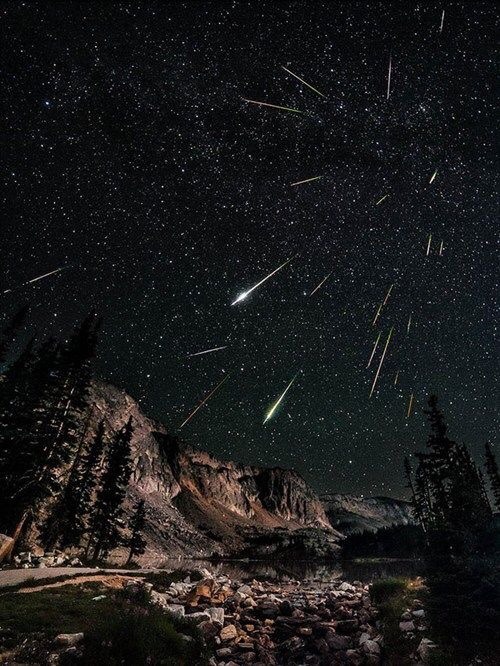Photo

This might look like a double-bladed lightsaber, but these two cosmic jets actually beam outward from a newborn star in a galaxy near you. Constructed from Hubble Space Telescope image data, the stunning scene spans about half a light-year across Herbig-Haro 24 (HH 24), some 1,300 light-years away in the stellar nurseries of the Orion B molecular cloud complex. Hidden from direct view, HH 24's central protostar is surrounded by cold dust and gas flattened into a rotating accretion disk. As material from the disk falls toward the young stellar object it heats up. Opposing jets are blasted out along the system's rotation axis. Cutting through the region's interstellar matter, the narrow, energetic jets produce a series of glowing shock fronts along their path. Image Credit: NASA, ESA, Hubble Heritage (STScI/AURA)/Hubble-Europe Collaboration; Acknowledgment: D. Padgett (NASA's GSFC), T. Megeath (U. Toledo), B. Reipurth (U. Hawaii)
#astronomer#astrophotography#astrophysics#astronaut#astronomy#nasa image of the day#nasa#photographer#photo#photographers on tumblr#photooftheday#photography#cosmos#star#galaxy#universe#space
805 notes
·
View notes
Photo

#astronomer#astrophotography#astrophysics#astronaut#astronomy#nasa image of the day#nasa#photographer#photo#photographers on tumblr#photooftheday#photography#cosmos#universe#space#star#nature photography#nature#planet
10K notes
·
View notes
Photo

Did you know?
#astronomer#astrophotography#astrophysics#astronaut#astronomy#star#galaxy#planet#photooftheday#photographer#photo#photographers on tumblr#photography#space#nasa#nasa image of the day
3K notes
·
View notes
Photo

#as#astronomer#astrophotography#astrophysics#astronaut#astronomy#nasa image of the day#nasa#photographer#photo#photographers on tumblr#photooftheday#photography#galaxy#star#planey#cosmos#universe#space#color#colorful#nature photography#natural
3K notes
·
View notes
Link
#NASA#Astronomy#astronaut#NASA image of the day#astrophysics#astrophotography#breaking news#news#latest news#cosmos#star#galaxy#universe#space#color#planet#sun#moon#night#night sky
201 notes
·
View notes
Photo

Not all roses are red of course, but they can still be very pretty. Likewise, the beautiful Rosette Nebula and other star forming regions are often shown in astronomical images with a predominately red hue, in part because the dominant emission in the nebula is from hydrogen atoms. Hydrogen's strongest optical emission line, known as H-alpha, is in the red region of the spectrum, but the beauty of an emission nebula need not be appreciated in red light alone. Other atoms in the nebula are also excited by energetic starlight and produce narrow emission lines as well. In this gorgeous view of the Rosette Nebula, narrowband images are combined to show emission from sulfur atoms in red, hydrogen in blue, and oxygen in green. In fact, the scheme of mapping these narrow atomic emission lines into broader colors is adopted in many Hubble images of stellar nurseries. The image spans about 100 light-years in the constellation Monoceros, at the 3,000 light-year estimated distance of the Rosette Nebula. To make the Rosette red, just follow this link or slide your cursor over the image. Image Credit & Copyright: Eric Coles and Mel Helm
#astronomer#astrophotography#astrophysics#astronaut#astronomy#nasa#nasa image of the day#photographer#photo#photographers on tumblr#photooftheday#photography#cosmos#universe#star#galaxy#color#colorful
742 notes
·
View notes
Photo







Jupiter, a wonder.
#astronomer#astrophotography#astrophysics#astronaut#astronomy#nasa#nasa image of the day#jupiter#planet#star#night#night sky#cosmos#space#photographer#photo#photographers on tumblr#photooftheday#photography#colorful
14K notes
·
View notes
Photo

Wolf Galaxy
#astronomer#astrophotography#astrophysics#astronaut#astronomy#nasa#nasa image of the day#photographer#photo#photographers on tumblr#photooftheday#photography#star#night#night sky#universe#galaxy#planet#color#constellation
12K notes
·
View notes
Photo


Don't panic. It's just a spacesuited mannequin named Starman. As the sunlit crescent of planet Earth recedes in the background, Starman is comfortably seated at the wheel of a Tesla Roadster in this final image of the payload launched by a Falcon Heavy rocket on February 6. Internationally designated 2018-017A, roadster and Starman are headed for space beyond the orbit of Mars. The successful Falcon Heavy rocket has now become the most powerful rocket in operation and the roadster one of four electric cars launched from planet Earth. The other three were launched to the Moon by historically more powerful (but not reusable) Saturn V rockets. Still, Starman's roadster is probably the only one that would be considered street legal.
#astronomer#astrophotography#astrophysics#astronaut#astronomy#astro#star#cosmos#night#night sky#galaxy#photographer#photo#photographers on tumblr#photooftheday#photography#universe
221 notes
·
View notes
Photo


#NASA#Astronomy#astronaut#astrophysics#astrophotography#NASA image of the day#photo#photography#photographer#photooftheday#photographers on tumblr#cosmos#space#star#night#night sky#galaxy#sky#moon
23K notes
·
View notes
Link
#astronomy#astrophotography#astronaut#astrophysics#space#star#photographers on tumblr#photography#physics#photo#galaxy#planet#night#night sky
111 notes
·
View notes
Photo

The comet PanSTARRS also known as the blue comet (C/2016 R2) really is near the lower left edge of this stunning, wide field view recorded on January 13. Spanning nearly 20 degrees on the sky, the cosmic landscape is explored by well-exposed and processed frames from a sensitive digital camera. It consists of colorful clouds and dusty dark nebulae otherwise too faint for your eye to see, though. At top right, the California Nebula (aka NGC 1499) does have a familiar shape. Its coastline is over 60 light-years long and lies some 1,500 light-years away. The nebula's pronounced reddish glow is from hydrogen atoms ionized by luminous blue star Xi Persei just below it. Near bottom center, the famous Pleiades star cluster is some 400 light-years distant and around 15 light-years across. Its spectacular blue color is due to the reflection of starlight by interstellar dust. In between are hot stars of the Perseus OB2 association and dusty, dark nebulae along the edge of the nearby, massive Taurus and Perseus molecular clouds. Emission from unusually abundant ionized carbon monoxide (CO+) molecules fluorescing in sunlight is largely responsible for the telltale blue tint of the remarkable comet's tail. The comet was about 17 light minutes from Earth. Image Credit & Copyright: JoAnn McDonald
#astronomer#astrophotography#astrophysics#astronaut#nasa#nasa image of the day#photographer#photo#photographers on tumblr#photooftheday#photography#colorful#space#galaxy#star#universe#night#night sky
189 notes
·
View notes
Photo

#NASA#Astronomy#astronaut#astrophysics#astrophotography#photo#photography#photographer#photooftheday#photographers on tumblr#space#universe#nature#nature photography#NASA image of the day#star#night#Night Sky
1K notes
·
View notes
Link
#space#cosmos#Astronomy#astronaut#NASA#NASA image of the day#astrophysics#astrophotography#astronomer#star#galaxy#photo#news
354 notes
·
View notes
Photo

#astronomer#astrophotography#astronaut#space#star#cosmos#planet#nature photography#photographer#photo#photooftheday#photography#photographers on tumblr#colorful
3K notes
·
View notes
Photo

#astronomer#astrophotography#astrophysics#astronaut#nasa#photographer#photo#photooftheday#photography#photographers on tumblr#colorful#sky#star#space#cosmos
6K notes
·
View notes